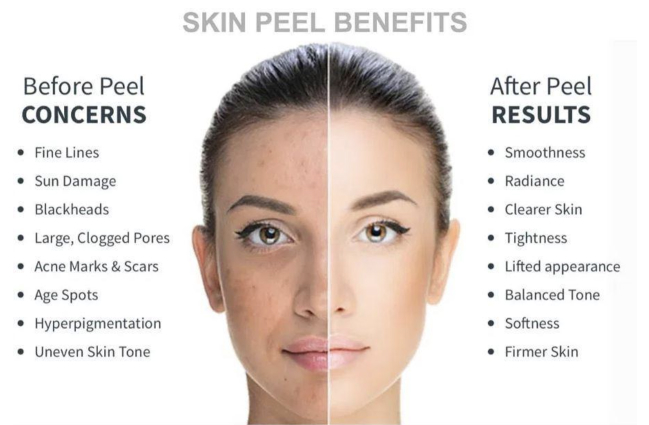What is a Chemical Peel?
A chemical peel is a non-invasive cosmetic procedure that uses a chemical solution to exfoliate and rejuvenate the skin. A chemical solution is applied to the skin during the treatment, causing it to react and eventually peel off. New, regenerated skin comes to the surface to replace the skin that falls away. This new skin is smoother and more evenly pigmented, with fewer lines and wrinkles.
Chemical peel options include alpha hydroxy acid, beta hydroxy acid, retinoic, glycolic, and lactic acids. Since there are many options, we always recommend a new client facial with one of our professionals to help determine the right peel for your skin type, tendencies, and needs.
Chemical Peels offer one of the least invasive options for improving the appearance of your skin. The term “chemical peeling” sounds harsh, and the history of chemical peels was aggressive, leaving patients with mixed feelings about the process. Now, there are peels for every skin type and tolerance that are not as aggressive. Most peels take less than an hour to perform, and there is minimal discomfort during the treatment.
While you will see improvements after one treatment, it is recommended to have peels done in a series of three over three months for a marked improvement in skin texture and tone. Peeling is a possible side effect of treatment but is not always required to see great results.
The Benefits of a Chemical Peel
Chemical peels offer a multitude of benefits for your skin, including:
Improved Skin Texture: By exfoliating the outer layer of dead skin cells, chemical peels help to smooth rough, uneven skin texture and promote a softer, more refined complexion.
Reduced Fine Lines and Wrinkles: Chemical peels stimulate collagen production in the skin, which can help to minimize the appearance of fine lines, wrinkles, and other signs of aging, leaving you with a more youthful-looking complexion.
Diminished Hyperpigmentation: Whether caused by sun damage, acne scars, or melasma, hyperpigmentation can be frustrating for many individuals. Chemical peels target excess pigment in the skin, helping to fade dark spots and achieve a more even skin tone.

Acne Improvement: Chemical peels effectively treat acne and prevent future breakouts. By unclogging pores, reducing inflammation, and regulating oil production, they can help clear acne-prone skin and minimize the risk of future blemishes.
Enhanced Radiance: One of the most noticeable benefits of a chemical peel is its radiant glow to the skin. By removing dull, lifeless skin cells, chemical peels reveal brighter, more luminous skin that appears revitalized and refreshed.
Suggested services for first-time guests: New Client Facial or Signature Facial ( link services to booking site)
Here’s a day-by-day guide for Post Peel Clients:
Day 1 (Immediately After the Peel): Follow Post-Peel Instructions: Detailed instructions on aftercare will be given verbally and electronically. Client Education: what to expect in the coming days, emphasizing the importance of compliance with post-peel care.
Day 2-3 (Peeling Phase): Observation: Monitor the skin for peeling, flaking, or crusting signs. Hydration: Emphasize the need for adequate hydration and gentle skincare during this phase. Sun Protection: Reinforce sun protection measures to prevent UV damage.
Day 4-7 (Recovery and Healing): Moisturize: Use hydrating products to support skin repair. Avoid: Picking or pulling at peeling skin.
Day 8+ (Follow-Up): Follow-Up Appointment: Schedule a follow-up treatment two weeks post-peel to assess long-term results and address new concerns.
Sun exposure
Myth: You cannot be in the sun if you get a chemical peel!
Here’s what you should know about being in the sun after a chemical peel:
- Sun protection is crucial post-peel. Sunscreen with a high SPF (30 or more) is a must.
- Avoid direct sun exposure during the initial healing phase (usually a few days).
- Wear protective clothing (hats, sunglasses, etc.) to shield your skin.
Limit sun exposure during peak hours (10 am to 4 pm).
